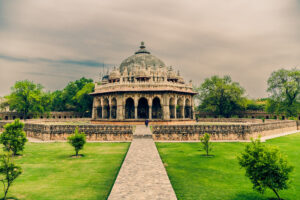Qutub Complex UNESCO World Heritage Site the layers of history converge in the Qutub archaeological complex. It was commissioned by Qutub-ud-din Aibak, founder of the Mamluk dynasty or Slave dynasty, who later became the first “Sultan of Delhi”. The Delhi Sultanate is a collective term that refers to the dynasties that ruled, one after the other, from Delhi. The Delhi Sultanate established in the beginning of twelfth century


In its beautiful gateways, tombs, lofty screens, and pillared colonnades is a record of a centuries-long history of artistic vision, unique building techniques, and patronage






Apart from the famous Qutb Minar there are many structures in the complex known for remarkable architectural heritage, these includes the Quwwat ul-Islam Mosque, Alai Darwaza, the Alai Minar, the Iron pillar, the tombs of Iltutmish, Alauddin Khalji and Imam Zamin

The Quwwat-ul-Islam mosque also known as the Qutb Mosque of Delhi and it was probably the first mosque built Delhi and the oldest surviving example of Ghurids architecture in Indian subcontinent. The ensemble of mosques, minars, and other structures in the Qutb complex is an outstanding testimony to the Indo-Islamic architectural and artistic achievements. The 13th-century square tomb of Iltutmish in the north-western part of Quwwatu’l-Islam marks the beginning of the tradition of constructing royal tombs, a practice followed as late as the Mughal era in India

The iron pillar within Qutub complex is one of the world’s foremost metallurgical curiosities. The pillar, 7.21-metre high and weighing more than six tonnes, was originally erected by Chandragupta II Vikramaditya (375–414 AD) around 402 AD, and in the 10th century the pillar shifted to its present location
The unique iron pillar is stands remained rust-free since it was fabricated in around 400 AD

Qutb Minar ‘The Victory Tower’ named after the religious figure Sufi Saint Hazrat Khwaja Qutbuddin Bakhtiar Kaki, was begun by Qutb-ud-din Aibak. It was continued by his successor Iltutmish (a.k.a. Altamash), and finally completed much later by Sultan Firoz Shah Tughlaq, a Sultan of Delhi from the Tughlaq dynasty in 1368 AD. Many subsequent rulers, including the Tughlaqs, Alauddin Khalji and the British added structures to the complex

Built of red and buff sandstone and eloquently carved with inscriptional bands, the Qutb Minar is the tallest masonry tower in India, measuring 72.5 metres high, with projecting balconies for calling all Muadhdhin to prayer



The Qutub Minar was probably inspired by the Minaret of Jam in Afghanistan; one of the excellent examples Indo-Islamic art and architecture. The Minar is 72.5 m (239 ft) high, making it the tallest minaret in the world built of bricks. It has five distinct storeys, each marked by a projecting balcony carried on muqarnas corbel and tapers from a diameter 14.3 m at the base to 2.7 m at the top, which 379 steps away. The Qutub Complex of monuments were designated as a World Heritage Site by the UNESCO in 1993




We are offering specially designed features and selected destinations to cater quality services for halal friendly tourism and hospitality in India. We ensure halal friendly travelers for the best of hospitality whilst on trips and holidays in India. During this process we have restructured the models of travel and hospitality by applying halal friendly features and amenities
With HalalTrip India, you’ll discover cultural intricacies and connections across a wide range of subject areas and themes including art, architecture, archaeology, history, and the natural image of this unique destination. Our services are a combination of vibrant Indian history and culture with gorgeous natural scenery. Our tours are not just ordinary tours, but meaningful experiences for the longest memories
Follow us – www.facebook.com/IndianHalalTourism
Follow us – https://www.instagram.com/halaltripindia/
Follow us – www.twitter.com/TourismHalal
Write us – travel.HalalTripIndia.com



